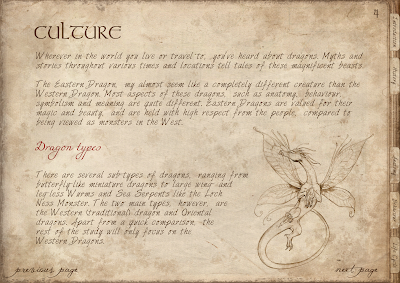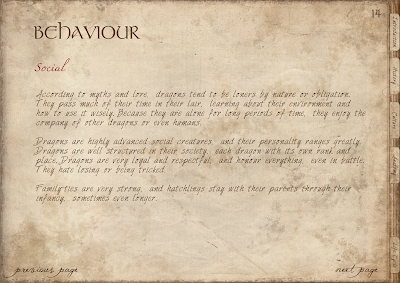Many of the concepts were inspired by already existing drawings of dragons. Due to the huge amount of dragon types, hardly any dragon is the same as the previous one, and the number of different varieties is mind-boggling.
During my conceptual research stage, I came across several sub-categories of dragons. Of course, the main ones being the archetypes, Western and Eastern dragons, but my search for inspiration branched to include only the Western dragons, as they are the ones that are more natural, traditional and "logical". Within the category of Western dragons, I could easily make out a few varieties that seem to belong to the same sort of group. I call these traditional, modern and elemental dragons.
Traditional dragons:
The stereotypical dragon that the majority of people think of when they hear the word "dragon". A large, majestic creature with a stream-like figure, both agile and strong at the same time. Upon a long and slim neck rests a chiselled narrow head with an arrow-like and almost beak-like snout. The head is crowned by horns that are sometimes connected by a membrane to form a very fin-like appearance. These "fins" can sometimes continue along the spine down to the tip of the tail. The legs of these dragons are long and shaped like felines or canines, and overall, the appearance is very feline - elegant, curved and deadly.
Modern dragons:
I've taken the liberty of naming these dragons "modern" because they have only recently made their appearance in art and games and differ quite a lot from the stereotypical dragon. The body is more stout and compact, with short, sturdy legs and hard skin. The neck is also a lot shorter, and the body is fairly broad compared to the stream-like features of its traditional cousin. The head is characterised with a small, deep-set eyes and a strong, jaw with a clear under-bite. This type of dragon is more reptile-like in its appearance, and the head remind a lot of a dinosaur's.
Elemental dragons:
The final type of dragons is the elemental dragon. These dragons don't share any common features with each other, but are fully or partly covered by a certain element, such as fire, ice or stone. Ice dragons are the most common of the group, where the dragon itself is covered in white scales and icicle spikes, and the wings are often only decorative rather than practical. Since these types of dragons don't follow the principle anatomy research, I haven't bothered designing any.
HEAD STUDY
Apart from anatomical studies, the first concepts I made were of the dragon's head. These were partly based on existing ideas and partly made up. Gathering inspiration for my final design is just as important as references make up a huge part of the conceptual process. These helped me greatly in getting a grasp of the large variety of dragons available as well as giving me plenty of ideas what's available for my final design.
QUICK DIGITAL CONCEPTS
The following step was to quickly draw down some initial concepts of full-body dragons. I wanted to get a feel of what it felt like to do these fast concept ideas, so after watching a few videos of the process I tried it myself. Although not as fast as I should have been, I enjoyed the rough greyscale figure/pose-focused exercise.
FULL-BODY CONCEPTS
After doing my quick concept ideas, I decided to go back to paper and think more carefully about the design of the actual body for the dragon. These were shaded, unlike the heads, to give a better idea of the muscles and overall body definition. I tried to include several different builds, both the feline and reptile ones to get a feel of which felt more natural. Because I wanted to concentrate more on the actual body, I didn't add any details or decorative spikes that would get in the way.
The final design of my dragon (for now) will be based on a combination of these builds and heads, with sufficient enough detail to make it interesting but not over-done. Although it is at this point hard to tell for sure how accurate the initial design will be to the final design, and it may well change during the 3D process.
























